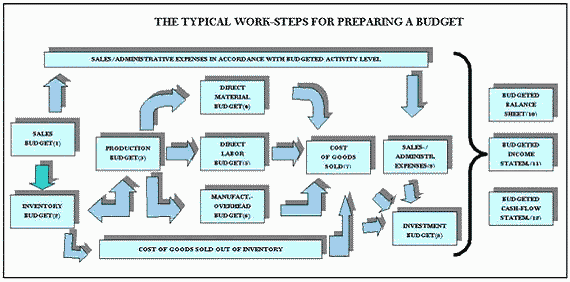Typical work-steps for preparing a budget
Category: Budgeting Methodology
The preparation of the budget should always start with the compilation of the sales budget. The sales budget provides for information as to the quantities of product which the company realistically expects to sell and the prices which it expects to achieve. 
Having determined the sales budget, the inventory budget has to be fixed. The above chart, for simplification reasons, shows only the interrelations between the sales budget, the (finished goods) inventory budget and the production budget. Budgeting, naturally, on the one hand has to take into account whether sales can be made through saleable products which are already in inventory, or whether the company intends to put during the budget period saleable products into inventory
The latter practice should be limited to specific cases e.g. the regrouping of orders of same products with different delivery dates, or the collection of different products to be expedited through one shipment.
The production budget then results from the sales budget minus sales of finished products out of inventory, plus finished products to be produced in order to be put into inventory.
Inventory, in real life, in addition consists of material, and work- in- process. Both these inventory categories have to be budgeted, if the overall company strategy – for whatever reasons — foresees substantial amounts related to them.
The production budget (i.e. the quantities of product planned to be produced) determine the direct material budget, the direct labour budget, and the manufacturing overhead budget. Budgeting here should be done using performance standards (norms) for direct material, direct labour and for the manufacturing overheads. The norms should reflect “attainable performance under efficient operating conditions”. Adequate manufacturing overhead distribution methods and manufacturing overhead absorption methods should be used when budgeting the manufacturing overheads.
The cost of goods sold budget are the total of the direct material cost, the direct labour cost, the manufacturing overheads and the cost of products sold out of inventory.
The sales & administration expense budget is set up taking into account the overall activity level as determined by the planned sales.
The planned investments are collected into an investment budget, the investment concerning in principle all areas of the company.
All budget information is ultimately consolidated into annual and monthly balance sheets, income statements, and cash-flow statements.
Two Excel life examples of a budget preparation are used for demonstration purposes throughout this document. They represent two fictional companies, one illustrating an environment where production is carried out on customer order (company Eurotransform, producing power transformers), the other one representing a process industry (tannery Top K). The two examples have been developed on the basis of real budget development projects in Ukraine – although for confidentiality reasons, details have been adjusted and concealed, and enhanced with additional details.
